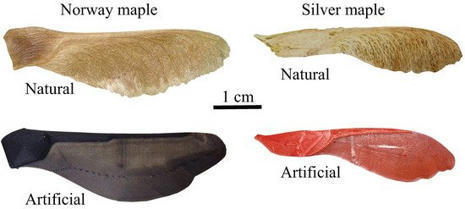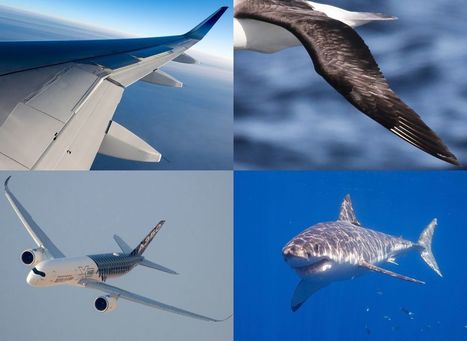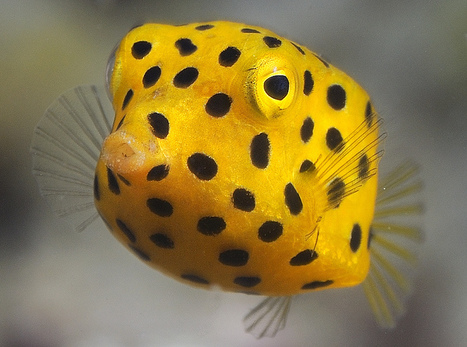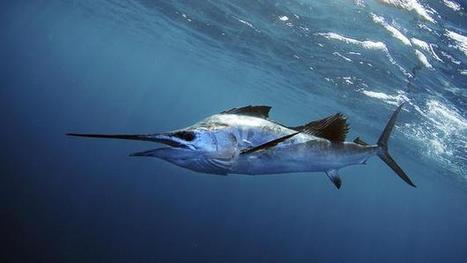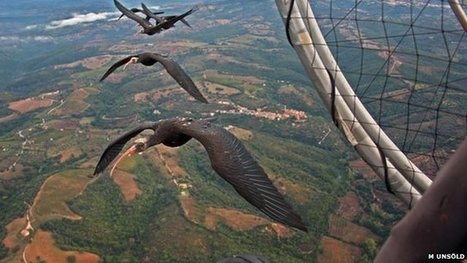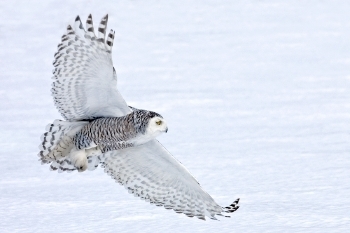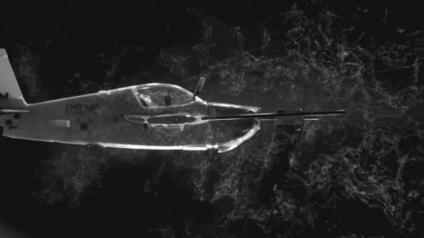 Your new post is loading...
 Your new post is loading...
"Maple trees (genus Acer) accomplish the task of distributing objects to a wide area by producing seeds, known as samaras, which are carried by the wind as they autorotate and slowly descend to the ground. With the goal of supporting engineering applications, such as gathering environmental data over a broad area, we developed 3D-printed artificial samaras. [...] This study demonstrated a bioinspired design for the dispersed deployment of sensors and provides a better understanding of wind-dispersal of both natural and artificial samaras."
The growing science of biomimicry focuses on what humanity can learn from the world, and Airbus engineers are learning quite a lot about efficient solutions for aircraft design that nature has spent millions of years refining.
"Many species of owl are able to hunt in effective silence by suppressing their noise at sound frequencies above 1.6 kilohertz (kHz) - over the range that can be heard by humans.
A team of researchers studying the acoustics of owl flight—including Justin W. Jaworski, assistant professor of mechanical engineering and mechanics at Lehigh University—is working to pinpoint the mechanisms that accomplish this virtual silence in order to improve the aerodynamic design of wind turbines, aircraft, naval ships and even automobiles. Now, the team has succeeded—through physical experiments and theoretical modeling—in using the downy canopy of owl feathers as a model to inspire the design of a 3D-printed, wing attachment that reduces wind turbine noise by 10 decibels without impacting aerodynamics."
Plenty of birds fly vast distances on their migratory trips around planet Earth. But the most amazing of all might the frigate bird, which can stay aloft for two months straight without landing or resting. How the heck do they do that?
A team of biologists led by Henri Weimerskirch at the French National Center for Scientific Research just announced the results of a major new study on great frigates (Fregata minor), these fascinating seabirds native to the central Indian and Pacific Oceans. Using super-lightweight GPS trackers, the biologists followed four dozen birds from 2011 to 2015, some for up to two years continuously. What they found was astonishing. The birds could stay aloft for up to 56 days without landing, gliding for hundreds of miles per day with wing-flaps just every 6 minutes, and reaching altitude of more than 2.5 miles.
"In 2005, Mercedes-Benz revealed a concept car with a strange shape. Called the Bionic, the cartoonishly snub-nosed vehicle was modeled after Ostracion cubicus, the yellow boxfish. Car manufacturers aren’t the only ones to take inspiration from this weird coral dweller. But researchers now say engineers who mimicked the boxfish might have been misled."
"[...] In a macroscopic axis, the A350 XWB considers the actively deformation of the surfaces to provide the best aerodynamic performance and control of load for each flight conditions; takeoff, climb, cruise, approach, landing, maneuver, turbulence-encounters, etc. This is what birds, fish and marine mammals perform beautifully, called "morphing". The idea is to move from a 'rigid' world to flexibility and adaptation technologies."
As long as there have been people watching birds, there have been theories as to how and why they do what they do. In the modern era, theories about why birds flock and why they migrate in v-formations have abounded, yet answers have been few. But new research using creative technology on both starling murmurations and bald ibis’ migration reveals that complex flight dynamics and rapid-fire adjustments based on sensory feedback previously believed impossible for birds are indeed occurring.
The sailfish can swim faster than a cheetah can run – and the secrets behind its speed inspired McLaren’s Frank Stephenson to create a new car.
Researchers are developing a bio-inspired unmanned aircraft capable of soaring like birds, boosting energy efficiency and endurance. The research team is aiming to be the first in the world to demonstrate an autonomous unmanned aircraft that can mimic birds by using updrafts around buildings to stay airborne.
"The mystery of why so many birds fly in a V formation may have been solved. Scientists from the Royal Veterinary College fitted data loggers to a flock of rare birds that were being trained to migrate by following a microlight. This revealed that the birds flew in the optimal position - gaining lift from the bird in front by remaining close to its wingtip. The study, published in the journal Nature, also showed that the birds timed their wing beats."
"What do velvet, the skin of a shark, and advancements in aircraft aerodynamics have in common? The answer rests in a field of scientific study that involves examining what can be extracted, learned and duplicated from the natural world. Known as ‘biomimicry,” or biologically inspired engineering, this is the study and imitation of nature’s best ideas to help solve human challenges. A growing number of aeronautical innovations have been inspired by an array of natural structures, organs and materials – and these tried and tested patterns of the natural world will continue to be a powerful source of inspiration in the future." Photo details: Bald Eagle , Morris Valley Road, Harrison Mills, British ColumbiaCopyright © 2008, Alan D. Wilson. http://www.naturespicsonline.com
"Who would have guessed that the design of an electric passenger train had been influenced by animal biology?"
|
"To build more aerodynamic machines, researchers are drawing inspiration from an unlikely source: the ocean. A team of evolutionary biologists and engineers at Harvard University, in collaboration with colleagues from the University of South Carolina, have shed light on a decades-old mystery about sharkskin and, in the process, demonstrated a new, bioinspired structure that could improve the aerodynamic performance of planes, wind turbines, drones and cars."
"The habits and anatomy of birds are being used by boffins at Airbus to develop quieter and more fuel efficient planes. The aviation giant, which makes and designs wings in Broughton, Flintshire, and Filton, Gloucestershire, employs Professor Norman Wood to unlock the mysteries of the natural world to help gain a commercial advantage.
It is using so-called ‘biomimicry’ in the design of intelligent wings that react automatically to the environment, just as an eagle’s or a peregrine falcon’s do."
"[The new] 454’s wheels feature a lumpy rim profile, called SawTooth, that Zipp claims delivers unrivaled stability in crosswinds while also improving aerodynamics. For the 454, Zipp looked to humpback whales and, specifically, the lumps on the leading edges of their pectoral fins. Called tubercles, these protrusions make humpbacks more agile by keeping water attached to their flippers when they turn. In the same way that a plane can stall when air separates from the wing during high-speed maneuvers, uncontrolled turbulence over a whale’s flipper makes turning more difficult. Tubercles keep the water attached as it flows past. Zipp says its SawTooth tubercles, which the company calls “Hyperfoils,” make deep-section rims more stable in crosswinds by forcing air to slip around and off the rims in a much more predictable manner.
"Moving silently through the air is not just for the birds. Wind farms inspired by the stealthy flight of owls could generate more energy without annoying those who live nearby, say researchers."
Many owls have the extraordinary ability to fly in almost complete silence. Could this adaptation have implications for the way we design aircraft? Photo details: Snowy Owl, Saint Barthelemy, Near Montreal, Quebec. Copyright © 2010, Alan D. Wilson. http://www.naturespicsonline.com
"Inspired by nature's own anti-turbulence devices – feathers – researchers have developed an innovative system that could spell the end of turbulence on flights. Researchers from the Unmanned Systems Research Team at RMIT University in Melbourne, Australia, have lodged a provisional patent on the system, which mimics the way feathers help birds detect disturbances in the air."
"[...] The wing tips of steppe eagles are an ideal shape to maximize lift with a minimal wingspan. The curvature at the end of the wing reduces drag. Engineers designing the A380 copied that design, resulting in fuel savings of up to 3%, depending on if it is a long or short distance flight."
Bats appear to use a network of hair-thin muscles in their wing skin to control the stiffness and shape of their wings as they fly, according to a new study. The finding provides new insight about the aerodynamic fine-tuning of membrane wings, both natural and man-made.
Caltech researchers uncover a mechanism for how fruit flies regulate their flight speed, using both vision and wind-sensing information from their antennae.
"Low noise levels are important in industries where the user can benefit from having the air compressor within close proximity to the work station, such as in the woodworking or automotive industry. The GA VSD+ uses a technologically advanced fan to help achieve noise levels low enough for a normal conversation to be held while the machine is running. The fan blade utilizes a design with a serrated edge that is inspired by the aerodynamic and mostly silent wings of an owl. With an aerodynamic design, the fan needs less energy to cleave through the air, making it more energy efficient."
The connection between humpback whales and helicopters might not seem obvious. But a group of researchers in Germany are thinking way outside-the-box, applying nature’s design to helicopters to make them faster and more maneuverable.
|






 Your new post is loading...
Your new post is loading...
